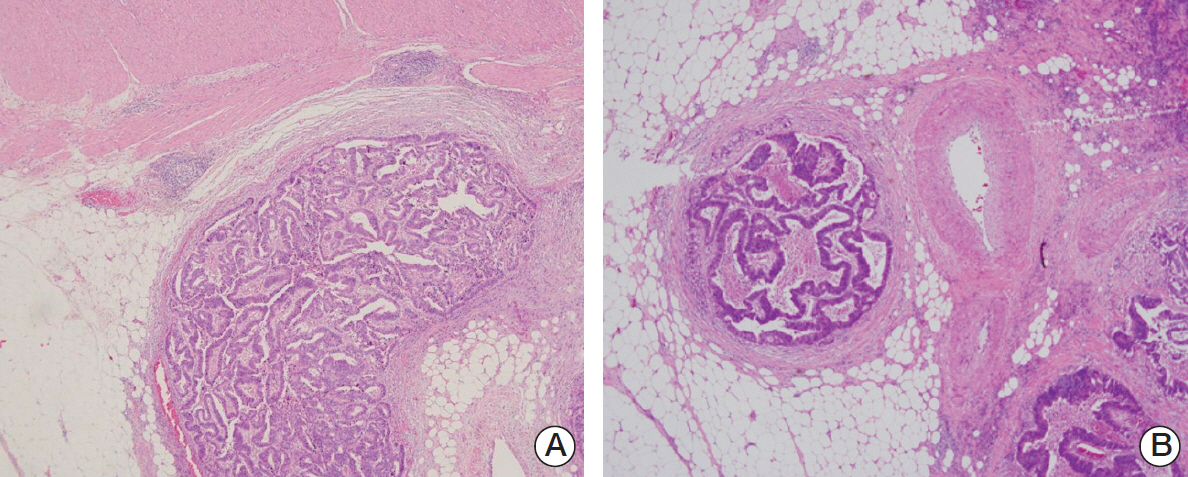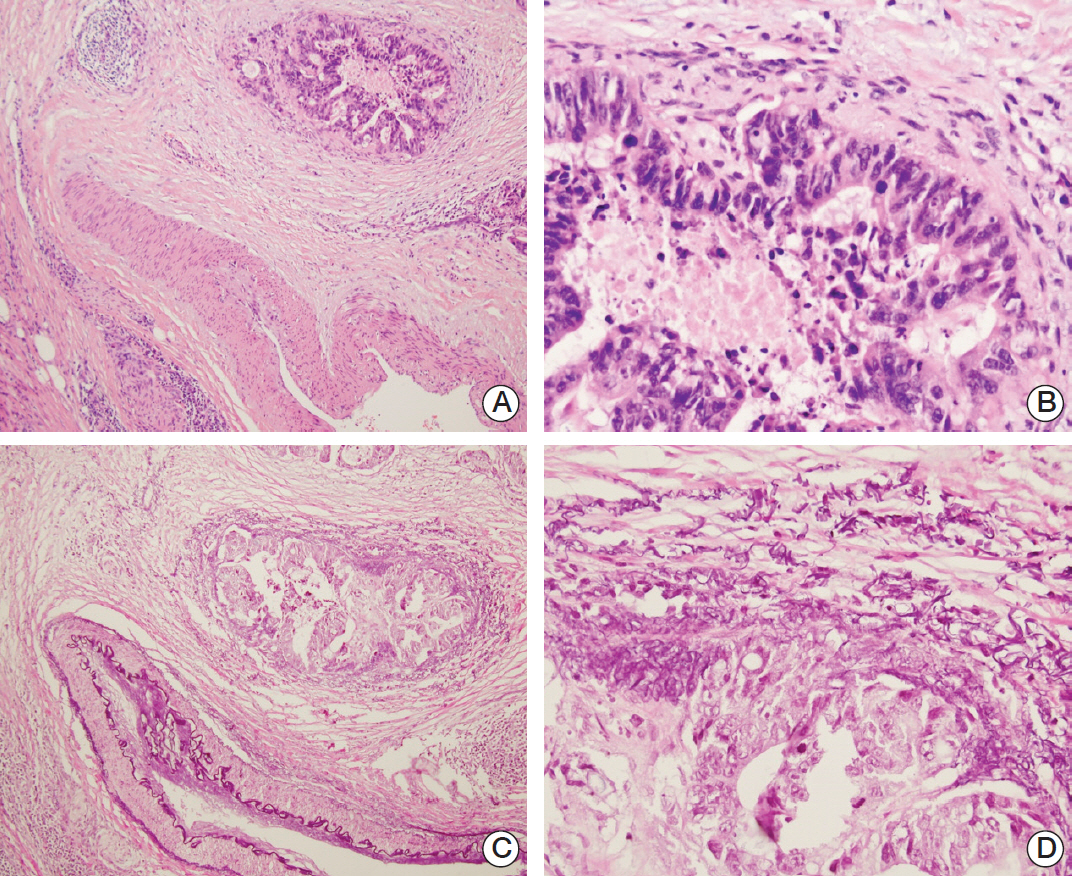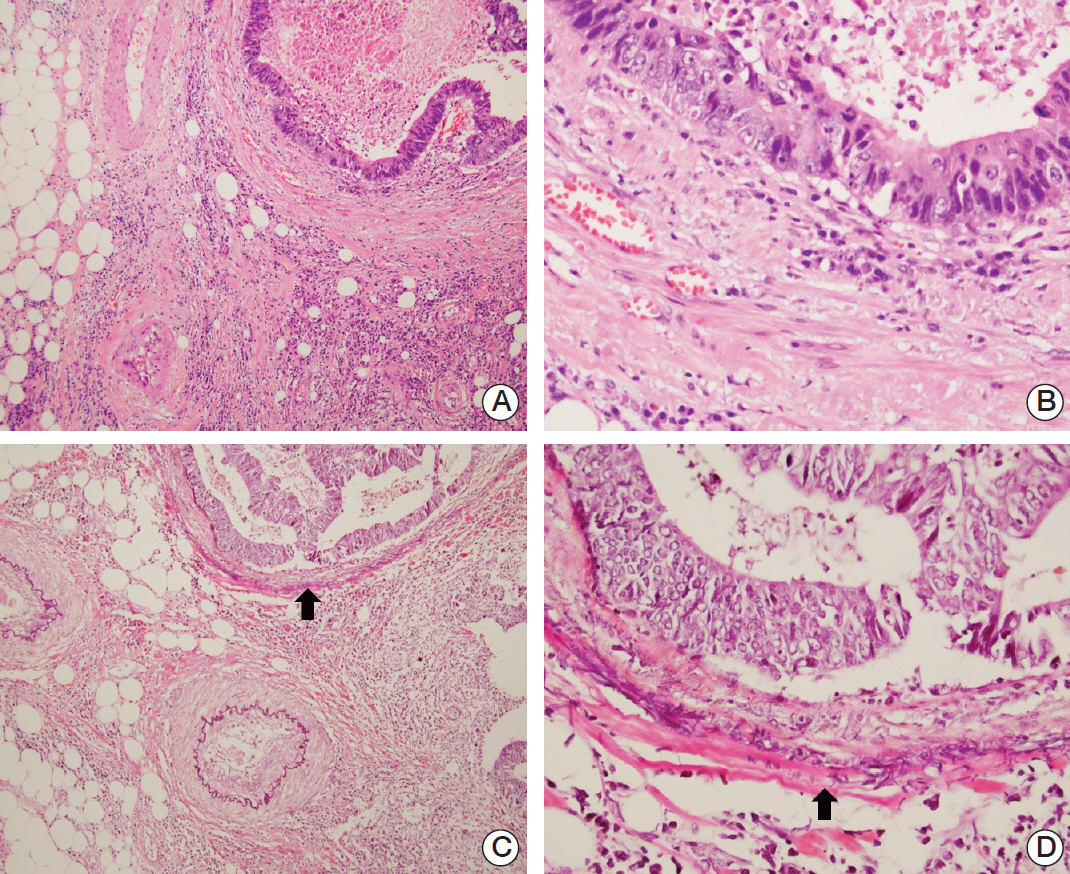Cancer Res Treat.
2016 Oct;48(4):1222-1228. 10.4143/crt.2015.429.
Venous Invasion in Colorectal Cancer: Impact of Morphologic Findings on Detection Rate
- Affiliations
-
- 1Department of Pathology, Biomedical Research Institute, Pusan National University Hospital, Pusan National University School of Medicine, Busan, Korea. pdy220@pusan.ac.kr
- KMID: 2356224
- DOI: http://doi.org/10.4143/crt.2015.429
Abstract
- PURPOSE
Venous invasion (VI) is widely accepted as a poor prognostic factor in colorectal cancer (CRC), and is indicated as a high-risk factor determining the use of adjuvant chemotherapy in CRC. However, there is marked interobserver and intraobserver variability in VI identification and marked variability in the real prevalence of VI in CRC.
MATERIALS AND METHODS
We investigated the detection rate of VI in 93 consecutive cases of T3 or T4 CRC based on the following: original pathology report, review of hematoxylin and eosin (H&E) slides with attention to the "protruding tongue" and "orphan arteriole" signs, and elastic stain as the gold standard.
RESULTS
Overall, the detection rate of VI was significantly increased as follows: 14/93 (15.1%) in the original pathology report, 38/93 (40.9%) in review of H&E slides with attention to the "protruding tongue" and "orphan arteriole" signs, and 45/93 (48.4%) using elastic stain. VI detection based on morphologic features showed 77.8% sensitivity and 91.1% specificity and showed a linear correlation (Spearman correlation coefficient, 0.727; p < 0.001) with VI detected by elastic stain. In addition, improved agreement between detection methods (detection on the basis of morphologic features, κ=0.719 vs. original pathology report, κ=0.318) was observed using kappa statistics.
CONCLUSION
Slide review with special attention to the "protruding tongue" and "orphan arteriole" signs could be used for better identification of VI in CRC in routine surgical practice.
Keyword
MeSH Terms
Figure
Reference
-
References
1. Washington MK, Berlin J, Branton P, Burgart LJ, Carter DK, Fitzgibbons PL, et al. Protocol for the examination of specimens from patients with primary carcinoma of the colon and rectum. Arch Pathol Lab Med. 2009; 133:1539–51.
Article2. Chang HJ, Park CK, Kim WH, Kim YB, Kim YW, Kim HG, et al. A standardized pathology report for colorectal cancer. Korean J Pathol. 2006; 40:193–203.3. Chapuis PH, Dent OF, Fisher R, Newland RC, Pheils MT, Smyth E, et al. A multivariate analysis of clinical and pathological variables in prognosis after resection of large bowel cancer. Br J Surg. 1985; 72:698–702.
Article4. Harrison JC, Dean PJ, el-Zeky F, Vander Zwaag R. From Dukes through Jass: pathological prognostic indicators in rectal cancer. Hum Pathol. 1994; 25:498–505.
Article5. Knudsen JB, Nilsson T, Sprechler M, Johansen A, Christensen N. Venous and nerve invasion as prognostic factors in postoperative survival of patients with resectable cancer of the rectum. Dis Colon Rectum. 1983; 26:613–7.
Article6. Betge J, Pollheimer MJ, Lindtner RA, Kornprat P, Schlemmer A, Rehak P, et al. Intramural and extramural vascular invasion in colorectal cancer: prognostic significance and quality of pathology reporting. Cancer. 2012; 118:628–38.7. Merkel S, Wein A, Gunther K, Papadopoulos T, Hohenberger W, Hermanek P. High-risk groups of patients with Stage II colon carcinoma. Cancer. 2001; 92:1435–43.
Article8. Krasna MJ, Flancbaum L, Cody RP, Shneibaum S, Ben Ari G. Vascular and neural invasion in colorectal carcinoma. Incidence and prognostic significance. Cancer. 1988; 61:1018–23.9. Abdulkader M, Abdulla K, Rakha E, Kaye P. Routine elastic staining assists detection of vascular invasion in colorectal cancer. Histopathology. 2006; 49:487–92.
Article10. Dirschmid K, Lang A, Mathis G, Haid A, Hansen M. Incidence of extramural venous invasion in colorectal carcinoma: findings with a new technique. Hum Pathol. 1996; 27:1227–30.
Article11. Messenger DE, Driman DK, McLeod RS, Riddell RH, Kirsch R. Current practice patterns among pathologists in the assessment of venous invasion in colorectal cancer. J Clin Pathol. 2011; 64:983–9.
Article12. Morris M, Platell C, de Boer B, McCaul K, Iacopetta B. Population-based study of prognostic factors in stage II colonic cancer. Br J Surg. 2006; 93:866–71.
Article13. Maughan NJ, Morris E, Forman D, Quirke P. The validity of the Royal College of Pathologists' colorectal cancer minimum dataset within a population. Br J Cancer. 2007; 97:1393–8.
Article14. Kirsch R, Messenger DE, Riddell RH, Pollett A, Cook M, Al-Haddad S, et al. Venous invasion in colorectal cancer: impact of an elastin stain on detection and interobserver agreement among gastrointestinal and nongastrointestinal pathologists. Am J Surg Pathol. 2013; 37:200–10.15. Howlett CJ, Tweedie EJ, Driman DK. Use of an elastic stain to show venous invasion in colorectal carcinoma: a simple technique for detection of an important prognostic factor. J Clin Pathol. 2009; 62:1021–5.
Article16. Loughrey MB, Quirke P, Shepherd NA. Dataset for colorectal cancer histopathology reports [Internet]. London: The Royal College of Pathologists;2016. [cited 2016 Feb 5]. Available from: https://www.rcpath.org/resourceLibrary/dataset-for-colorectal-cancer-histopathology-reports--3rd-edition-.html.17. Stephen A, Brown I, Ellis D, Hawkins N, Hicks S, Hunter A, et al. Colorectal cancer structured reporting protocol [Internet]. Surry Hills: The Royal College of Pathologists of Australasia;2012. [cited 2016 Feb 2]. Available from: http://www.rcpa.edu.au/getattachment/95109a49-9e15-4038-9858-cf314d9c7422/Protocol-colorectal-cancer.aspx.18. Kojima M, Shimazaki H, Iwaya K, Kage M, Akiba J, Ohkura Y, et al. Pathological diagnostic criterion of blood and lymphatic vessel invasion in colorectal cancer: a framework for developing an objective pathological diagnostic system using the Delphi method, from the Pathology Working Group of the Japanese Society for Cancer of the Colon and Rectum. J Clin Pathol. 2013; 66:551–8.
Article19. Messenger DE, Driman DK, Kirsch R. Developments in the assessment of venous invasion in colorectal cancer: implications for future practice and patient outcome. Hum Pathol. 2012; 43:965–73.
Article20. Dawson H, Kirsch R, Driman DK, Messenger DE, Assarzadegan N, Riddell RH. Optimizing the detection of venous invasion in colorectal cancer: the ontario, Canada, experience and beyond. Front Oncol. 2014; 4:354.
Article
- Full Text Links
- Actions
-
Cited
- CITED
-
- Close
- Share
- Similar articles
-
- Is the oncological impact of vascular invasion more important in right colon cancer?
- Prognostic Value of Preoperative Serum Levels of CEA and CA19-9 in Patients with Colorectal Cancer
- Prevalence of Liver Metastasis of Colorectal Cancer According to Clinical and Histopathologic Characteristics
- Colon Cancer Screening—Is It Necessary to Start under the Age of 50?
- Equipment-Based Image-Enhanced Endoscopy for Differentiating Colorectal Polyps




